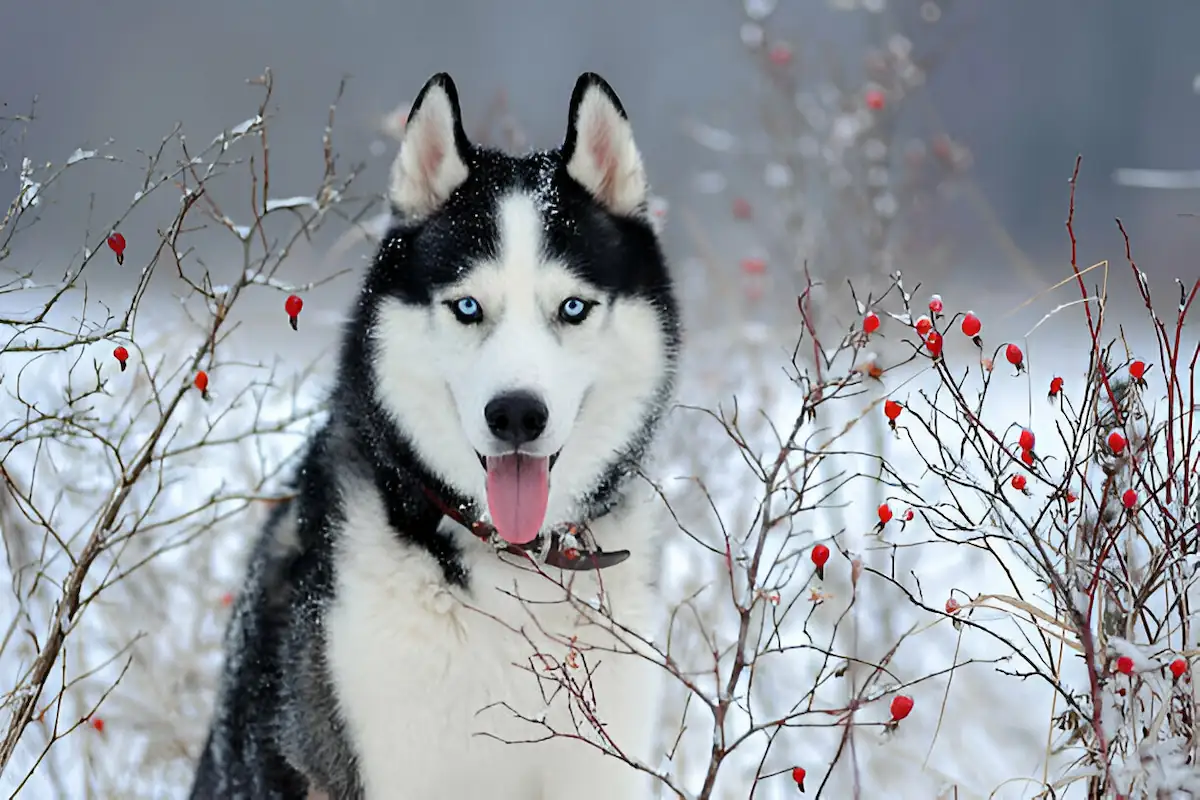Introduction
Siberian Huskies are medium-sized working dogs known for their wolf-like appearance, energetic nature, and friendly disposition. These dogs originated from Siberia and were bred by the Chukchi people for sled pulling and endurance in harsh climates. Today, they are popular as family pets and working dogs, known for their loyalty and intelligence.
Here’s a comprehensive guide to help you track your Siberian Husky’s growth and weight, along with some must-know health facts.
Monitoring your Husky’s growth and weight is crucial to ensure they are developing properly and maintaining good health. By understanding the growth stages and average weight ranges for Huskies, you can better care for your furry companion and address any health concerns promptly.
Siberian Husky Growth Phases
Puppyhood (Birth to 6 Months): During this stage, Siberian husky puppies experience rapid growth and development. They will gain weight quickly, and their bodies will undergo significant changes as they transition from newborns to juveniles.
Adolescence (6 Months to 2 Years): As Huskies enter adolescence, their growth rate begins to slow down, but they will continue to gain muscle mass and develop their adult features. This stage is crucial for proper bone and muscle development.
Adulthood (2 Years and Beyond): Once Huskies reach adulthood, their growth will slow down significantly, and they will reach their full size and weight. It’s essential to monitor their weight during this stage to prevent obesity and other health issues.
Average Growth and Weight
The average weight of a Siberian Husky can vary depending on their age, sex, genetics, and overall health. Generally, male Huskies weigh between 45 to 60 pounds (20 to 27 kg), while female Huskies weigh between 35 to 50 pounds (16 to 23 kg). However, these are just averages, and individual Huskies may fall outside these ranges.
husky weight chart kg
Male Husky Weights kg & Heights by Age
The following husky age chart contains the average weights and heights of a male Husky from newborn to 3 years of age. Please note these are only averages. Always consult with your veterinarian if you have any concerns about your Husky’s growth.
| Age | Average Weight (lbs) | Average Weight (kg) | Average Height (inches) | Average Height (cm) |
|---|---|---|---|---|
| Newborn | 0.5 – 1.3 | 0.2 – 0.6 | 3 – 4 | 7.6 – 10.2 |
| 1 month | 5 – 10 | 2.3 – 4.5 | 5 – 8 | 12.7 – 20.3 |
| 2 months | 10 – 20 | 4.5 – 9.1 | 8 – 11 | 20.3 – 27.9 |
| 3 months | 20 – 30 | 9.1 – 13.6 | 10 – 14 | 25.4 – 35.6 |
| 4 months | 30 – 40 | 13.6 – 18.1 | 12 – 16 | 30.5 – 40.6 |
| 5 months | 35 – 45 | 15.9 – 20.4 | 14 – 18 | 35.6 – 45.7 |
| 6 months | 40 – 50 | 18.1 – 22.7 | 16 – 20 | 40.6 – 50.8 |
| 7 – 12 months | 45 – 60 | 20.4 – 27.2 | 20 – 24 | 50.8 – 61 |
| 2 years | 45 – 65 | 20.4 – 29.5 | 21 – 24 | 53.3 – 61 |
| 3 years | 45 – 65 | 20.4 – 29.5 | 21 – 24 | 53.3 – 61 |
Female Husky Weight kg & Heights by Age
The following husky age chart contains the average weights and heights of a female Husky from newborn to 3 years of age. Please note these are only averages. Always consult with your veterinarian if you have any concerns about your Husky’s growth.
| Age | Average Weight (lbs) | Average Weight (kg) | Average Height (inches) | Average Height (cm) |
|---|---|---|---|---|
| Newborn | 0.5 – 1 | 0.2 – 0.5 | 3 – 4 | 7.6 – 10.2 |
| 1 month | 4 – 8 | 1.8 – 3.6 | 4 – 7 | 10.2 – 17.8 |
| 2 months | 8 – 18 | 3.6 – 8.2 | 7 – 10 | 17.8 – 25.4 |
| 3 months | 18 – 26 | 8.2 – 11.8 | 9 – 13 | 22.9 – 33.0 |
| 4 months | 26 – 36 | 11.8 – 16.3 | 11 – 15 | 27.9 – 38.1 |
| 5 months | 30 – 40 | 13.6 – 18.1 | 12 – 17 | 30.5 – 43.2 |
| 6 months | 35 – 45 | 15.9 – 20.4 | 14 – 19 | 35.6 – 48.3 |
| 7 – 12 months | 40 – 55 | 18.1 – 24.9 | 17 – 22 | 43.2 – 55.9 |
| 2 years | 40 – 55 | 18.1 – 24.9 | 18 – 22 | 45.7 – 55.9 |
| 3 years | 40 – 55 | 18.1 – 24.9 | 18 – 22 | 45.7 – 55.9 |
These tables are based on general guidelines and can vary greatly depending on individual dogs. Always consult with a veterinarian or professional breeder for more specific information about your pet’s growth and development.
Siberian Husky Veterinary Costs
When the worst happens to our beloved pets, the last thing we should be thinking about is how to cover the costs of vital veterinary care. This is where pet insurance comes in. Pet insurance reimburses you for up to 90% of veterinary expenses, so you can take care of your dog in the worst-case scenario. Like humans, dogs live longer and require excellent veterinary care to maintain a happy and healthy quality of life. Pet insurance makes this possible by providing you with a financial safety net in case your Siberian suffers an accident or injury or develops a disease such as cancer.
Additionally, many pet insurance policies offer the option of wellness supplements that reimburse you for the cost of regular veterinary care, such as annual checkups and routine blood tests. By providing routine veterinary care, your vet can check your Siberian Husky for health problems, so that health problems that arise can be treated quickly and early when the prognosis is generally better.
Your Siberian Husky is a beloved family member who deserves top-notch veterinary care. Don’t wait for the worst to happen to your puppy. Buy Pet Insurance today and have peace of mind knowing your pup is covered in case something happens to them.
Monitoring Your Husky’s Growth
Regular veterinary check-ups are essential for monitoring your Husky’s growth and overall health. Your vet can provide you with guidance on your Husky’s weight and growth progress and can detect any potential health issues early on.
Healthy Growth Indicators
Signs of healthy growth in Huskies include a gradual increase in weight, proper muscle development, and a shiny, healthy coat. If your Husky is not meeting these growth indicators, consult your vet for advice.
Nutrition for Optimal Growth
A balanced diet is crucial for the proper growth and development of Siberian husky puppies. They require a diet rich in protein, vitamins, and minerals to support their growing bodies. As they age, their dietary needs may change, so it’s essential to adjust their diet accordingly.
Exercise and Development
Regular exercise is vital for the growth and development of Huskies. They are an active breed that requires plenty of physical activity to stay healthy and happy. Providing them with opportunities for exercise, such as daily walks, runs, or playtime, can help support their growth and development.
Growth Concerns and Solutions
If you notice that your Husky is not growing as expected or is experiencing weight issues, it’s essential to consult your vet. They can help identify the underlying cause of the problem and recommend appropriate solutions, such as dietary changes or medical treatment.
What is the nutritional requirements of a Siberian Husky?
In general, it is best to feed your Husky number a mix of commercial dog food and raw diets. You need a diet rich in protein, so giving a balanced commercial food combined with raw red meat can meet your nutritional needs.
At what age are Siberian Huskies full-grown?
It usually takes Husk people a year and a half to reach their adult size, but they can fill your body for up to a year and a half. If your puppy is less than a year and a half old, he is probably still growing and you can expect changes.
How do you train a 1-year-old husky?
Offering treats and using an encouraging voice is an effective combination to get your Husky to repeat good behavior. This is called “positive reinforcement” or “respect training.” Make sure you distribute rewards quickly so your Husky understands what behavior to replicate.
How much bigger will my Siberian Husky get?
There are several ways to estimate how much bigger your Siberian Huskies will get:
Friend. If your puppy is less than a year old, he definitely still needs to grow! Most Siberian husky puppies need at least 15 months to complete growth and fill their breasts.
Genetics. If you purchased your Siberian dog from a breeder, you can contact them regarding your puppy’s estimated adult weight and height. Based on your Siberian parents and your past litter, your breeder should be able to give you a more accurate estimate of how big your puppy will be.
Paw size. Finally, take a look at your puppy’s paws. While this isn’t a perfect science, paws that look oversized next to your puppy’s body may be an indication that your puppy is still growing and filling out.
Conclusion
Monitoring your Siberian Husky’s growth and weight is an essential part of being a responsible pet owner. By understanding the growth stages and average weight ranges for Huskies, you can ensure that your furry friend is healthy and thriving. Remember to provide them with a balanced diet, regular exercise, and proper veterinary care to support their growth and development.
FAQs
- How often should I weigh my Siberian Husky?
- It’s a good idea to weigh your Husky once a month to track their growth progress. However, if you notice any sudden changes in their weight or appearance, consult your vet.
- Can Siberian Huskies be prone to obesity?
- Yes, Huskies can be prone to obesity if they are not fed a balanced diet and do not get enough exercise. It’s essential to monitor their weight and adjust their diet and exercise routine as needed to prevent obesity.
- Are there any health conditions that can affect a Husky’s growth?
- Yes, there are several health conditions that can affect a Husky’s growth, such as hypothyroidism, hip dysplasia, and certain nutritional deficiencies. Regular veterinary check-ups can help detect and treat these conditions early on.
- What is the lifespan of a Siberian Husky?
- Siberian Huskies typically live between 12 to 15 years, but this can vary depending on various factors, such as genetics, diet, and overall health care.
- Should I consult a vet if I notice changes in my Husky’s growth?
- Yes, if you notice any changes in your Husky’s growth, such as sudden weight loss or stunted growth, it’s essential to consult your vet. They can help determine the underlying cause and recommend appropriate treatment.

